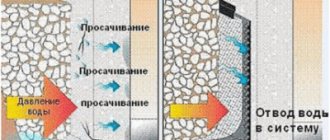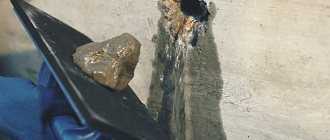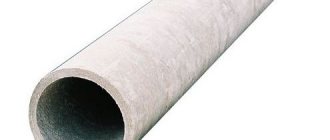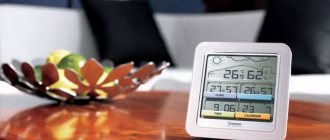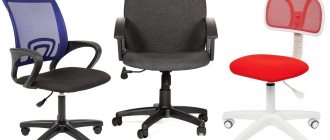In heating, water can reach 80-90°C. And if this is still normal for pipes with radiators, then for a heated floor this temperature is too high. To ensure normal standing on the floors, a three-way valve is used. Although it is not installed only for these purposes, it is indispensable in a system with almost any solid fuel boiler. Let's figure out what this mechanism is, what it is needed for and how to choose the right three-way valve for the heating and water supply system.
What is it and why is it needed
This is what a classic three-way valve for a heating system looks like.
As the name suggests, this valve has 3 strokes. You can even call it a tap, since it refers to shut-off and control valves. In appearance it is an ordinary tee, but inside its structure is much more complicated. Roughly speaking, it serves to change the temperature of the water. There are two methods: in the first, the return is mixed with the supply to lower the temperature; the second method, on the contrary, separates the flows, discharging hot water into the return line. This is useful in different cases:
- Warm floor . The return and heating supply are connected to the valve. Since the return is colder, water at a lower temperature is supplied to the floors. At the same time, the temperature of the rest of the heating remains the same.
- Temperature maintenance . For normal operation of almost any heating equipment, it is necessary that the return flow is not 60 degrees colder than the supply. Otherwise, the boiler will not last long. Therefore, the valve takes water from the supply and sends it to the return.
- Condensation protection . For the same reason. If water warmer than the dew point enters the heat exchanger, condensation begins to accumulate on it.
- Overheat protection . Modern boilers are equipped with various sensors. If it is, for example, a simple solid fuel boiler, it will continue to work even if it overheats. The three-way valve solves this problem.
- For piping an indirect heating boiler . To have hot water in the house, you can connect a boiler to the boiler. And then the water will be heated using heating. The three-way tap serves for uninterrupted supply of hot water. It opens when the water temperature in the boiler drops.
- When organizing a bypass . In some cases, it is necessary to direct water along an alternative path - a bypass. For example, for more efficient heating. The easiest way to do this is through a three-way valve. It will open and close at the right time.
But why install a valve when you can simply reduce the temperature? The question seems logical, but in fact, in conventional boilers at low temperatures, the heat exchanger quickly fails. A condensing boiler is better suited for this mode of operation, but their price is much higher. Therefore, it is better and easier to install a three-way valve.
As you can see, there are quite a lot of ways to use it. In some cases, it is used to improve the energy efficiency of the system. In others, it is an indispensable device for connecting equipment.
Purpose and design of a three-way valve
This device serves to mix and separate coolant flows circulating in one closed system. Separation or mixing of water flow is necessary if there are several circuits in a house or apartment that must operate in a strictly defined temperature range.
A classic example of such a system is the heating of a house or apartment, in which the main air heating is carried out by external radiators, and additional heating is performed by a so-called system. “warm floor”. If your home has rooms of different sizes, then it is logical that different amounts of coolant are needed to uniformly heat the air in the rooms. A larger room may have two or more radiators or one larger one, while the rest may have standard radiators.
The three-way valve serves to distribute the coolant while regulating its temperature. To do this, the valve device provides three outlets, due to which the mechanism looks like a regular tee. The function of a three-way valve, depending on the purpose and device, is limited to three tasks:
- mixing several streams of hot water into one;
- separation of one common coolant flow through several circuits;
- switching the flow of the working environment in certain directions.
We recommend that you read: Features of two-pipe wiring of a home heating system
Attention! The use of a three-way valve makes it possible to simplify the control of a heating function consisting of several circuits; the use of the device replaces a large number of shut-off and control valves - switches, valves, gate valves.
The three-way valve device is an all-metal body made of stainless steel, brass or cast iron, protected by galvanization. The body shape is T-shaped, consisting of two side and one lower pipe. Inside the device there is a mixing chamber and a thermal head, which performs the function of controlling the temperature of the coolant.
A rod having one or two flat or spherical (ball) valves is attached to the thermal head inside the valve. Moving the valve inside the valve opens the top passage to start hot water and closes the other two passages.
The valve is connected to the heating system in such a way that the coolant passes through the device from the supply and discharge circuits. Temperature regulation is carried out by mixing the cooled coolant from the so-called. heating system return with heated water from the boiler or boiler. Dosing of cooled water occurs automatically due to the operation of temperature sensors and an electric drive.
At a given temperature range, part of the valve that directs the flow of water into one circuit remains open so that cooled water flows freely into the underfloor heating system. As soon as the coolant reaches the desired temperature, to prevent further cooling, the valve shuts off the flow of cold water and opens the pipe with hot water from the supply circuit.
Design and principle of operation of a three-way valve in a heating system
To make it easier for you to understand the principle of operation, I suggest considering this diagram:
Sectional design of a three-way valve.
When it is necessary to achieve a certain temperature, the rod rises, opening the duct. This is reminiscent of the operating principle of shut-off valves. And the mechanism itself is called a saddle mechanism. Instead of a rod, a ball or a rotating sector is sometimes used. Exactly the same as in conventional ball valves. This mechanism is called a rotary mechanism. They can be depicted in the diagram as follows:
I’ll talk about what exactly controls the rod or ball a little later. For now, let's look at each type. Let's start with the mixing valves:
As you can see, hot water enters from the left and cold water from below. The rod rises when necessary, allowing the two streams to be mixed.
And this is what the operation of a separating valve looks like. Here, on the contrary, hot water enters from the right, and can exit to the left or down. If the temperature is normal, the rod rises. If higher temperatures are required, the rod is lowered, sending hot water downwards. That is, in the opposite direction.
From the instructions for the VMR type valve from Mut International.
Typically, thermomixing and separation valves do not close completely. But the switches, as you can see, close one of the pipes and open the other. In this case, no mixing or separation occurs.
Cross-section of a typical three-way valve.
Types of Three Way Valves
To understand what a three-way valve is on a heating system, you need to understand the classification of these fittings.
Depending on the operating principle, there are two types of three-way valves - mixing and separating.
A three-way mixing valve is used to combine flows of the working medium. Structurally, it is a mixing unit that is activated when the coolant is heated above the set value. In this case, the valve opens and mixes return water into the supply line, ensuring cooling of the coolant. The valve can also operate in the opposite direction - to heat the liquid in the return line.
The three-way distribution valve has one inlet and two outlets. It distributes the flow of the working medium between two lines in certain proportions. For example, if the coolant in the supply line overheats, part of it can be discharged into the return line, which reduces the heating of the radiators.
Saddle and swivel products
Depending on the design of the locking element, valves are seated and rotary.
In saddle-type devices, the locking element is a cone mounted on the rod. When it moves vertically. In the extreme position of the rod, the cone fits tightly into the seat and blocks the supply of the working medium in a certain direction. Partially or completely rising, the rod opens the supply in the appropriate volume.
The closing element in a rotary three-way valve is the rotating sector. When the rod moves, the ball valve is activated, which completely or partially closes or opens the supply of the working medium. Rotary valves are characterized by increased resistance to wear and can withstand significant fluctuations in the temperature of the working environment.
How to choose a three-way valve for a private home heating system
Now you know for what purposes certain types of valves are used. But this is not the only selection criterion, because the valves have several ways of regulating the temperature and different throughputs. Yes, and the material of manufacture may differ. Let's look at this in more detail.
Temperature control method
Manual.
Let's start with manual adjustment. Here the rod is connected to a valve or handle; under them there are marks, with the help of which the temperature is regulated. This is the simplest and cheapest method, so some consider it more reliable. But I believe that it all depends on the company: if the valve is of high quality, then with automatic adjustment it will work no less than with manual adjustment.
| Advantages | Flaws |
| Low price compared to other types of valves | You have to independently react to all changes in environmental conditions |
| Works without electricity connection | The heating circuit warms up unevenly |
Thermostatic.
If a thermostat is built into the design, such a valve is called thermostatic. Usually it is configured only once. Then he himself selects the position of the rod based on temperature fluctuations. A heat-sensitive liquid or gas is responsible for this: when the temperature rises, they expand and begin to move the rod. Such valves are either electronic or mechanical. A three-way valve with a thermostat is much more convenient than a manual one, since it operates automatically, but it also costs more.
| Advantages | Flaws |
| Automatic temperature control | High price compared to manual valves |
| Uniform heating of the heating circuit | |
| Mechanical models work without electricity |
With servo drive.
Three-way valves with electric drive are considered the most accurate. They have a built-in thermostat, but control occurs using an electronic unit that operates on a servo drive. When the temperature changes, the thermostat sends a signal to the controller. And now he controls the drive, raising or lowering the rod.
| Advantages | Flaws |
| Does not require human participation in temperature control | High price |
| Highest precision of any type of three-way valve | Electricity addiction |
| The highest quality and uniform heating heating | Increased energy consumption compared to electronic thermostatic valves |
I think it's better to go with the middle option. Manual adjustment is inconvenient, and the motorized valve is expensive. And such precision is rarely required in everyday life.
Material of manufacture
The durability of the product depends on the material used to make the case. I want to say right away that sometimes there are valves made of silumin. Although they are much cheaper, I do not recommend paying attention to them. And there are many other reliable materials:
- Black carbon steel valves are durable and relatively inexpensive. Unfortunately, they are susceptible to corrosion, so they are usually plated with nickel or chrome. Stainless steel is also often used, but such products are more expensive.
- Cast iron is strong, durable and does not corrode. But usually these are old-style valves, since more advanced materials are now used.
- The most popular are products made of brass and bronze. These are durable, strong and stainless materials. They cannot be used in industrial conditions where temperatures exceed 200 degrees, but they are ideal for domestic needs. I advise you to choose just such three-way valves; if the material is not indicated in the characteristics, it can always be identified by its characteristic color and texture.
I would also like to say something about ceramics. It is practically not used as a material for the body. But internal parts are often made from it. This is due to the fact that ceramics are not affected by chemicals. And it is also durable.
How to select and connect to the system the most important element - a security group
Temperature range and operating pressure
When choosing a three-way valve, the temperature adjustment range should also be taken into account. For example, a thermomixer for heated floors is usually set to 30-40°C. Although this range is the most comfortable for obtaining hot water. The maximum pressure that the valve can withstand also varies. Some models can withstand up to 16 bar. Although usually in domestic conditions more than 6 bar is not required. In general, the operating pressure values for these devices are regulated by GOST 26349-84.
Other
Of course, do not forget that three-way valves have different diameters of connecting pipes. The most common sizes for domestic use are 1 and ¾ inches. The thread can be internal or external.
The number of liters that passes through the valve per hour depends on the throughput indicators. The choice should be made so that the valve coefficient is slightly higher than the calculation result. For example, if the system flows 2 m³ per hour, a valve with a capacity of 2.5 m³ per hour should be selected.
But the throughput varies depending on whether the valve is fully open or slightly open. The ratio of these indicators is called the dynamic range of regulation. The higher the ratio, the better the throughput is maintained. The best odds are considered to be 100:1, but they are quite rare. The most common indicators are 50:1 or 30:1; valves with such indicators can be safely taken.
Device, purpose, principle of operation
In simplified terms, a three-way valve for heating is a structure that combines two water taps in one housing. Depending on its purpose, the device mixes, separates or redirects coolant flows. It consists of the following main elements:
- Cases.
- Curtain or spherical element.
- Fastening coupling.
The distribution mechanism can be either manual using a metal ball or automatic using a rod operated by an electric drive based on a signal from a thermostat.
Note! When installing a heating system for a private home, not only a three-way boiler valve is used, but also its two-way analogue. Its main difference is that the rod element does not block the flow of coolant with unchanged hydraulic characteristics.
The best known manufacturers and models: characteristics and prices
Now I want to talk about the most popular and reliable three-way valves to make it easier for you to choose the right model.
TIM
Manufacturer from China. It offers fairly high-quality products for heating and water supply at a relatively low price.
| Photo | Model | Specifications | Peculiarities | Cost, rub. |
| (ZEISSLER) BL3110C04 | Material: brass Temperature range: 35-60 Operating pressure: 2-5 bar Diameter: 1 inch | Mixing, for heating and hot water supply | 2 300-3 000 | |
| BL8803 | Material: brass Temperature range: 38-60 Operating pressure: 3-10 bar Diameter: ¾ inch | Mixing, external connection via American connection | 2 800-3 500 | |
| BL8804A | Material: brass Temperature range: 38-60 Operating pressure: 3-10 bar Diameter: 1 inch | Mixing, electrically driven | 2 000-2 600 |
Esbe
This Swedish company produces various models of valves and controllers. I believe that the products from this company are of the highest quality. Although expensive.
| Photo | Model | Specifications | Peculiarities | Cost, rub. |
| VTA321 | Material: brass Temperature range: 35-60 Operating pressure: 2-10 bar Diameter: ¾ inch | Mixing, for heating and hot water supply | 6 000-6 500 | |
| VTA372 | Material: brass Temperature range: 20-55 Operating pressure: 3-10 bar Diameter: 1 inch | Mixing, high throughput | 7 000-8 000 | |
| VTC511 | Material: cast iron Temperature range: 60-75 Working pressure: 3-10 bar Diameter: 1 inch | For solid fuel boilers | 8 000-9 000 |
STOUT
Joint production of Russia, Italy, Spain and Germany. The products are perfectly adapted to Russian conditions.
| Photo | Model | Specifications | Peculiarities | Cost, rub. |
| SVM-0120-164325 | Material: brass Temperature range: 20-43 Operating pressure: 3-10 bar Diameter: 1 inch | Mixing, for heating and hot water supply | 4 500-5 000 | |
| SVM-0125-186520 | Material: brass Temperature range: 30-65 Operating pressure: 3-10 bar Diameter: ¾ inch | Mixing, for heating | 4 000-4 300 | |
| SVM-0120-256025 | Material: brass Temperature range: 35-60 Operating pressure: 3-10 bar Diameter: 1 inch | Mixing, high throughput | 5 200-5 800 |
WATTS
One of the largest manufacturers of heating equipment in Europe. Huge range of products.
| Photo | Model | Specifications | Peculiarities | Cost, rub. |
| Aquamix 61C | Material: brass Temperature range: 32-50 Operating pressure: 3-10 bar Diameter: ¾ inch | Mixing, for DHW | 5 200-5 700 | |
| Aquamix 63C | Material: brass Temperature range: 25-50 Operating pressure: 1-10 bar Diameter: ¾ inch | Mixing, for heated floors | 5 500-6 000 | |
| V3GB Watts Classic | Material: brass Temperature range: 20-50 Operating pressure: 3-10 bar Diameter: 1 inch | Mixing, electrically driven | 12 500-14 000 |
Rules for installing fittings
Typically, the manufacturer indicates the movement of water flow with arrows on the body of a three-way valve. Using these guidelines, you can determine the type of valve. Connection to the system occurs as indicated by the arrows. The installation location should be convenient for subsequent adjustments or replacement in case of malfunction. Both return and supply are suitable for this. But read the instructions carefully, since not all valves can be installed for supply.
Since most of the valves inside are made of ceramic, they do not handle dirty water well. Therefore, it is better to install a filter in front of the valve. If this is not done, the device may become clogged. In some cases, it is enough to clean it, but sometimes even this does not save. Therefore, you should not skimp on filters.
The electric drive should not be located at the bottom, and mechanical thermostatic mixers are also not recommended to be installed this way, only vertically. But I can say from my own experience that in some cases this is possible. And reviews from some owners confirm this.
How to install a valve yourself
All types of three-way valves are installed in the system using threaded connections (special devices with internal or external threads are purchased), as well as crimp (compression) adapter elements.
Installing a three-way valve, depending on the type of device, has its own nuances. Any device requires strict adherence to the installation diagram in the pipeline, taking into account the hydraulic parameters of the system.
We recommend that you read: Why does condensation form in the chimney pipe and how to get rid of it?
Installation of a separating valve
The separating valve is installed on the return circuit of the heating system in front of the circulation pump, and its outlet pipe must be in the open position.
Attention! It is very important to install the valve in the correct position, focusing on the arrows marked by the manufacturer on the device body. The arrows indicate the direction of movement of the working medium. If an error is made in the installation, it can lead to improper operation of the system or even a serious accident.
Layout diagrams of a three-way valve in a heating system
The simplest scheme in a system with a solid fuel boiler. Purpose: protection against condensation and overheating, maintaining the temperature in the heating circuit.
Heating scheme with electric boiler and heated floors. Hydrocollectors are used to distribute heated floors into several circuits.
Use in piping using an indirect heating boiler, which allows organizing hot water supply with a single-circuit boiler.
Video description
The video shows a diagram of how the regulator works with a solid fuel boiler:
- The arrow on the body and the direction of the coolant in the system must coincide when installing the device.
- The correct installation is also determined by the designations on the device body - straight, perpendicular, bypass or combined stroke.
- Coolant distribution diagram.
It can be T-shaped or symmetrical, as well as L-shaped or asymmetrical.
Before the 3-way regulator is connected, the heating system must be switched off and the coolant pipe must be de-energized. In addition, it is important that there is no sediment inside the pipes. Otherwise, the device will quickly clog and deteriorate.
Important! It is necessary to install the thermal control valve on a section of the heating pipeline with open free space and easy access. In this case, the thermal head or drive after installation should not be located at the bottom of the housing. Since in the future, with the slightest leak, they will quickly deteriorate.
How to check a three-way valve for functionality
First of all, an external inspection should be carried out: there should be no cracks in the plastic and metal casing. As for the regulator, it should turn smoothly in all directions. To check the thermal head, it needs to be heated. For example, a hair dryer. In this case, the rod should move in accordance with the indicators. If the valve has an electric drive installed, you can check its functionality using a tester, but to do this you will have to disassemble the electric drive.
Conclusion
Three-way valves only resemble a tee in appearance. Their design is much more complex, and their applications are quite diverse. Choose a valve responsibly; consider only models from well-known, reputable manufacturers; fortunately, there are plenty of them. And then this small but very important device will work for many years without causing problems.
Boiler room equipment




